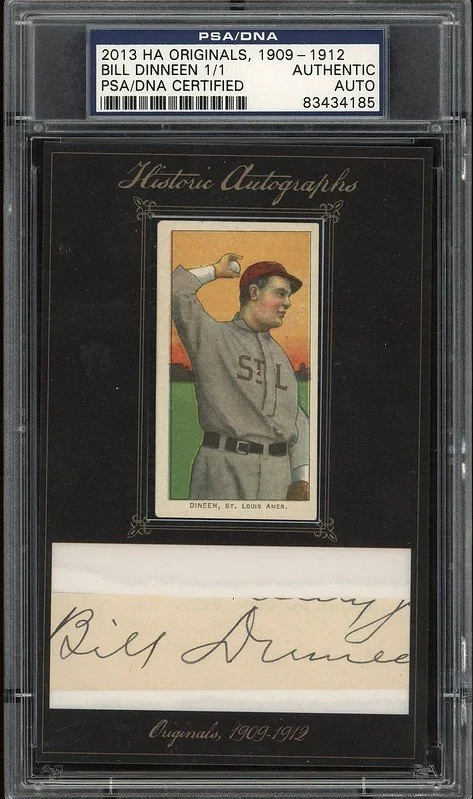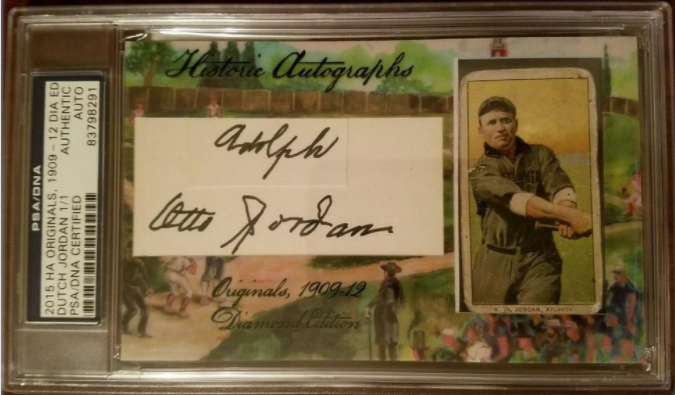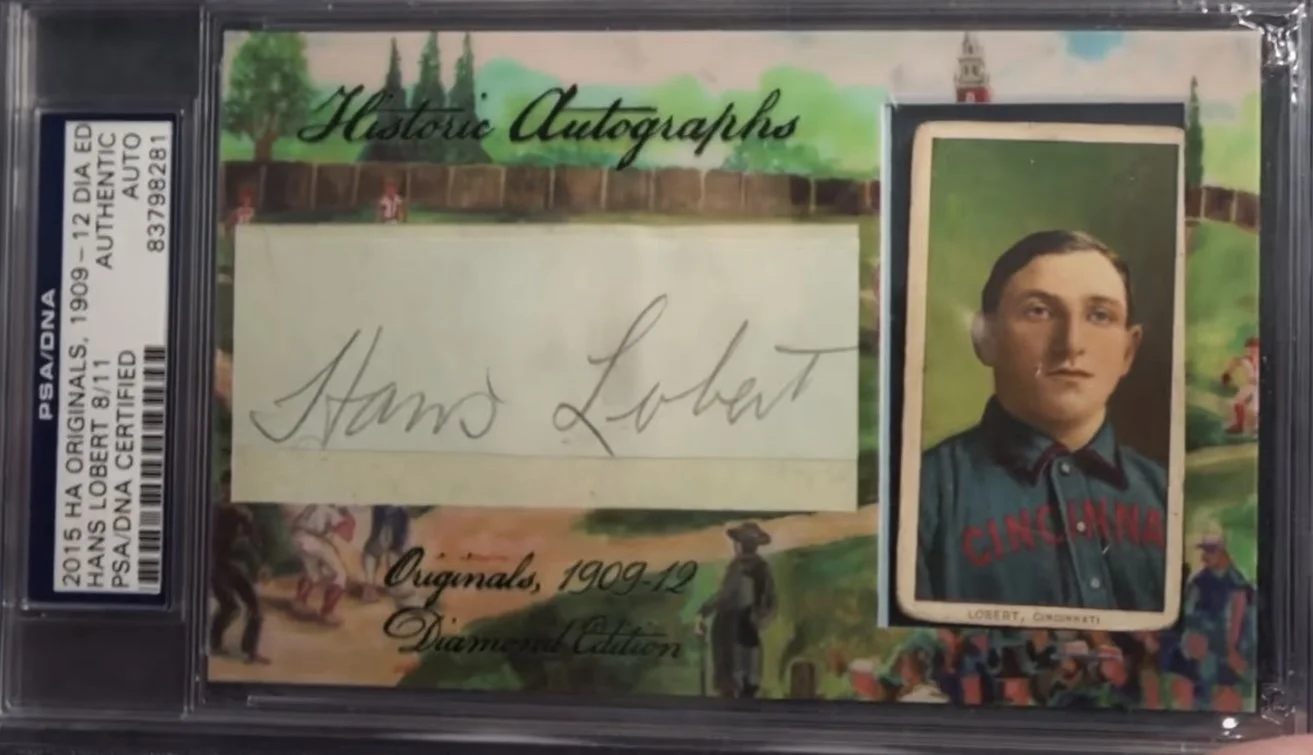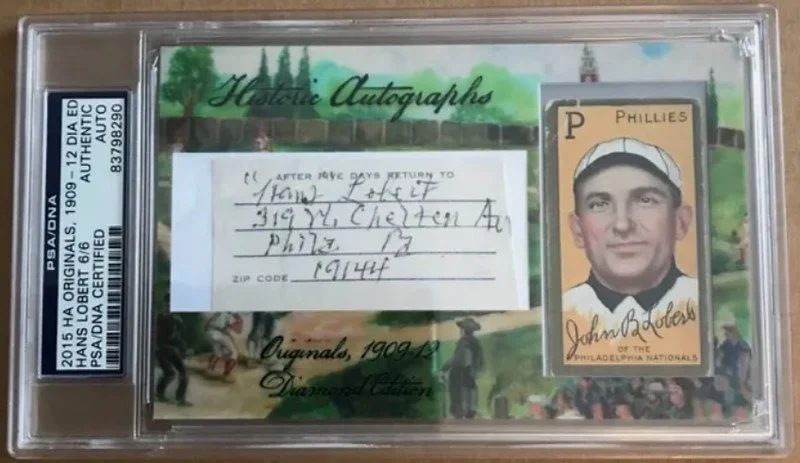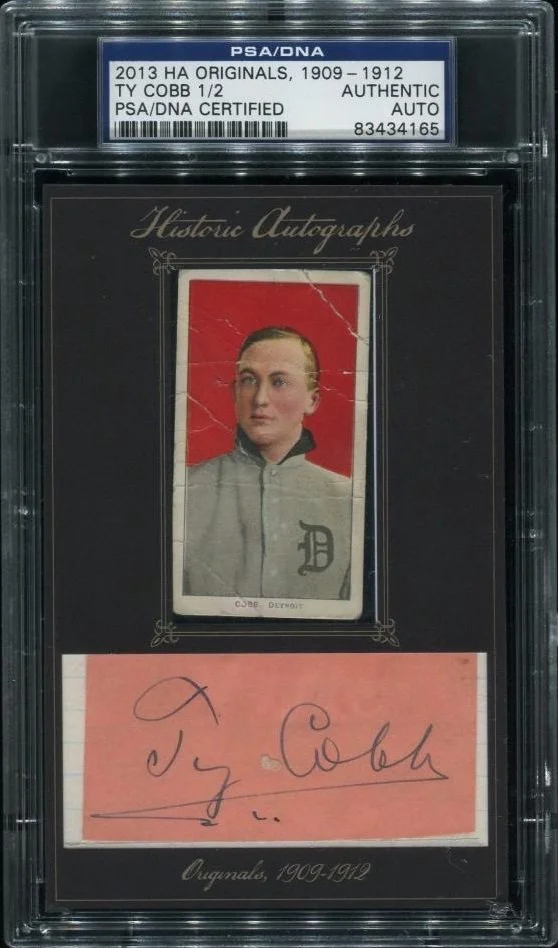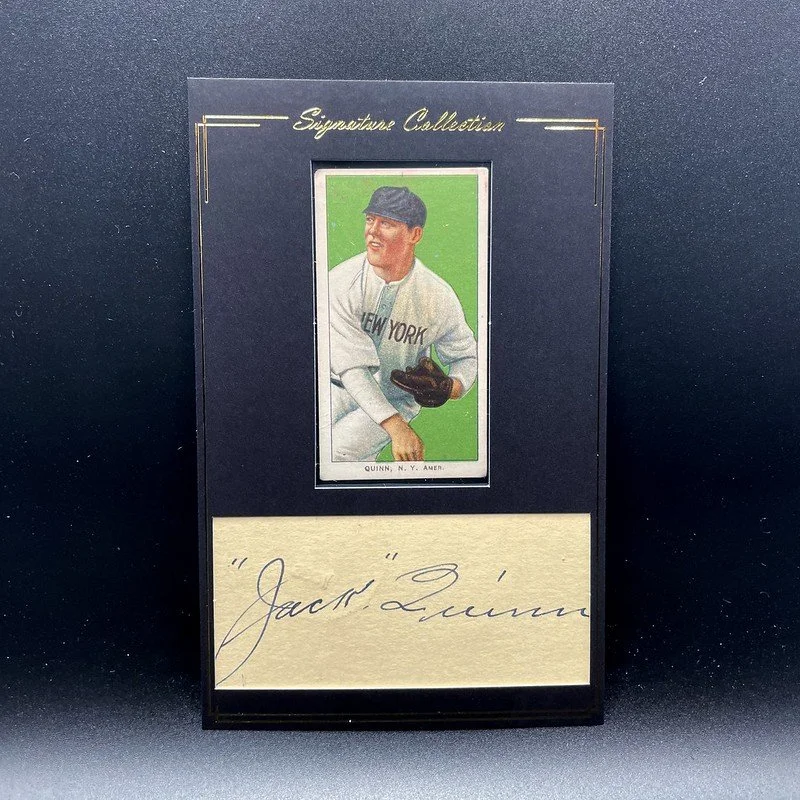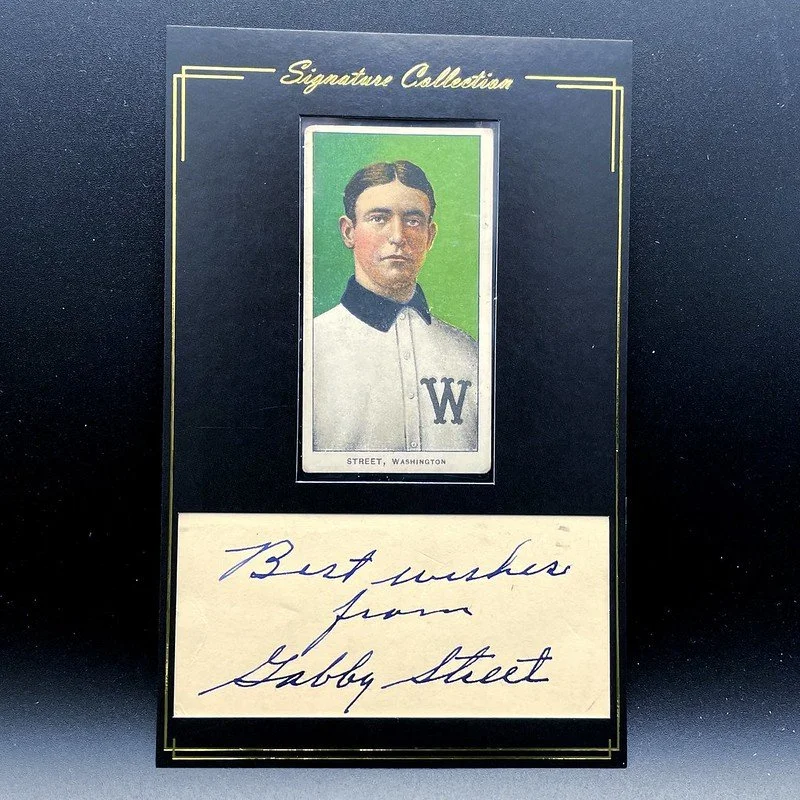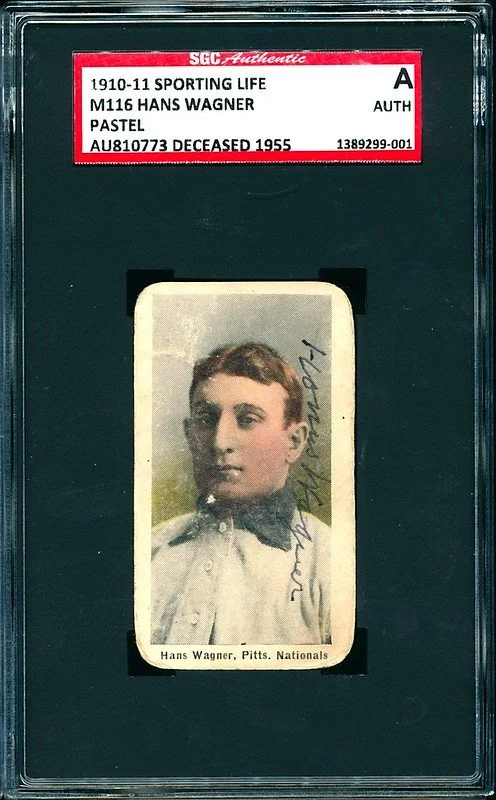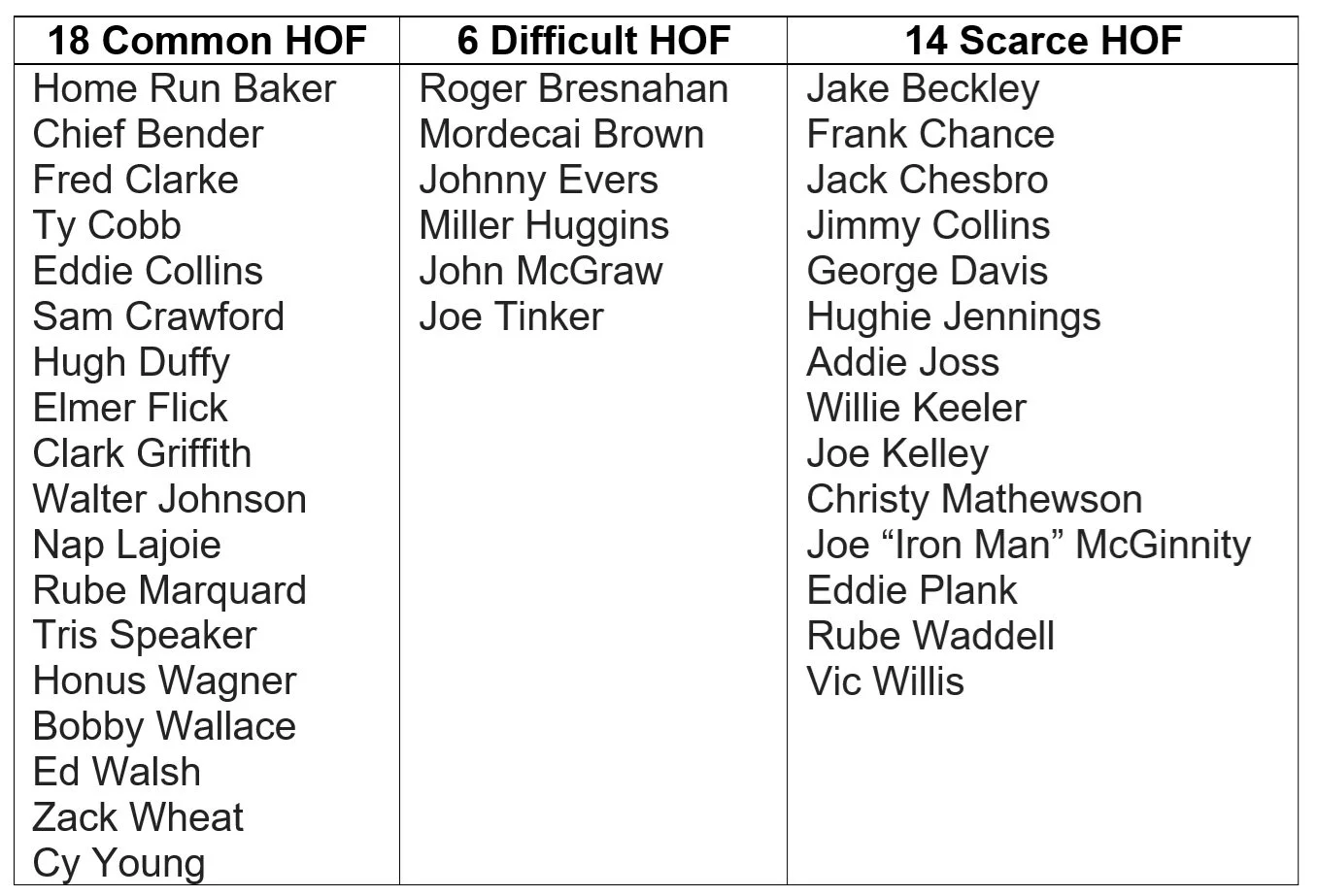The Relative Scarcity Of T206 Player AUtographs
MISSION STATEMENT
The purpose of this report is to categorize the relative scarcity of autographs of the 391 subjects featured on a T206 tobacco baseball card issued from 1909-11.
BACKGROUND
No third-party authenticator maintains population reports for autographs that were not issued with official baseball cards. But, since 2013, Historic Autographs (“HA”) has issued a number of sets pairing T206 player autographs with the subject’s tobacco card, including the following three which focused heavily on the T206 set:
2013 Originals 1909-13 (vertical orientation, black borders, PSA/DNA); 68 different subjects
2015 Originals Diamond Edition (horizontal orientation, image of 19th Century ballfield, PSA/DNA); 71 different subjects
2021 Triple Folders (cardboard folders akin to T202, Beckett authenticated); 98 different subjects
The population reports of these products provide a fair look at the relative scarcity of T206 player autographs. For each of these products, HA published population reports, either on the PSA flip (2013 and 2015) or on their WEBSITE (2021). For 2013 and 2015, the data is based on after-market images of PSA flips, which have not been uniformly or completely compiled. But, even the numbers on the flips from 2013 and 2015 can be somewhat deceiving because different populations were shown for autographs based on which tobacco card issue was paired with the autograph, at least in the 2015 product:
NOTE: The population of 2015 HA Originals with a Hans Lobert autograph appears to be at least 17 — 11 T206s + 6 T205s.
For example, 2015 HA Originals Diamond Edition Hans Lobert with a T206 is x/11, but with a T205 is x/6. Unfortunately, the population numbers are not verifiable on the PSA/DNA registry, which identifies the HA products only generically as “Trading Cards” without any reference to populations.
Finally, even if we had complete population reports, HA makes products for a profit and so the different prices they had to pay in the market for autographs and T206 cards in order to be able to include them in their products certainly may have skewed the results for purposes of determining relative populations. For instance, HA only included two Cobbs in their 2013 product. However, that doesn’t mean that Cobb T206 cards or his signature are at all rare — in fact, T206 Cobb cards his autograph are both extraordinarily abundant in the hobby. But, they are also among the most expensive given that massive demand for Cobb items still outpaces a strong supply.
In short, while we are able to reach a fairly good idea as to the relative populations from these products, they are best treated as estimates.
2021 HA Triple Folders gave us a relatively large population of T206 player autographs -- 98 (roughly 25% of the 391 subjects) were included. In other words, 98 of the 391 different player signatures are “available enough” – both in terms of scarcity and price point – that Historic Autographs included them in their 2021 product. Although the player autographs range substantially in terms of value and scarcity, they are – by definition – “in the hobby” (and not, for example, only in the Hall of Fame library or on a World War 1 draft registration card in the National Archives), because each is currently owned either by an autograph enthusiasts or dealer, and thus may become available to other collectors.
I also reviewed the autographs in several extensive collections, at least two with a focus specifically on T206 players. And I have compared the dates of death of nearly every one of the 391 players in the T206 set. The date of a player’s death is highly correlated to the availability of his signature in the hobby. Obviously, the longer the player lived and was able, available, and interested in signing an autograph request, the more that autographs of that player made it into the hobby. For this reason, it is not at all surprising that three of the players whose autographs do not appear in the hobby or elsewhere – including the records of the Hall of Fame – are Doc Powers (d.1909), Simon Nichols (d.1911), and Jiggs Donahue (d.1913). Candidly, the odds of finding an autograph of just about any of the 150 T206 players who died before 1945 are very low.
NOTE: Jack Quinn died in 1946, but his signature is still readily available.
There are exceptions. Meaningful participation in the game into the 1930s as a player, coach, executive, broadcaster, etc., more or less ensures autographs of that player will be available, even when paired with a death before 1950. For example, Jack Quinn died in 1946. But he was an active player into the 1930s and is the only player who was active as a player for the publications of both the T206 and 1933 Goudey sets. Quinn is one of only 29 players in baseball history to date who have appeared in a Major League game in four decades. He may not have lived to 1980 like Rube Marquard, but he was able, available, and interested in signing over a long period of time due to his extraordinary continuous baseball activity. So his autograph is the most available of the T206 players who passed away before 1950. This is why Quinn’s signature is available in all three HA issues in 2013, 2015 and 2021.
NOTE: Gabby Street died in 1951, but his signature is still readily available.
Similarly, even though Gabby Street died in 1951, his autographs are very easy to find. This is because he not only played regularly from 1904 through 1912, he was a successful manager during the 1930s (managing the Cardinals to a World Championship in 1931), and then a color commentator for Cardinals and Browns radio broadcasts after World War II, working with a young Harry Caray. So he played substantial roles in the game for nearly half a century and had plenty of time and opportunity to grant autograph requests.
100 T206 COMMON PLAYER AUTOGRAPHS
100 T206 player autographs represents a solid collector’s target that is possible to complete with serious effort. Yes, there are more than 100 common T206 player autographs in the hobby, but a collector will be challenged to get the 100 highlighted here, and struggle to get any others not on the list.
NOTE: In each quartile, players are listed in alphabetical order by last name, not in order of relative scarcity within quartiles. Prices will vary based on popularity of player and relative scarcity.
The relative scarcity of T206 common player autographs after the 100 listed here is nearly the same because there are so few, or even just no examples in the hobby. Indeed, over 100 of the exemplars in existence for common players beyond the 100 identified here are found only in the World War 1 draft registration cards that are available digitally on the National Archives website. And in some of those cases (e.g., Dutch Revelle) the registration card was signed by a surrogate because the player was illiterate. I also have spent nearly four years looking for exemplars of all 391 and am still missing 18 players that are not available anywhere, not even in the Hall of Fame’s records.
Collecting autographs of T206 players is not for completists. Finding all 391 is a literal impossibility. For perspective, Jack Smalling sold his legendary collection of baseball autographs dating back to 1871 for $180,000 in 2018. You can see that listing for nearly 14,000 different baseball autographs HERE.
As you can see, Heritage included a link to a PDF that listed every single one of the examples HERE.
If you match the Smalling list on the Heritage website against the list of 391 players in the T206 set, you will see that this Smalling lot of 13,831 only had 190 of those players, which is 200 shy of completion — not even halfway there!
38 HALL OF FAMER AUTOGRAPHS
There are 38 T206 subjects in the Baseball Hall of Fame. The 38 Hall of Famers list shows that 18 are fairly easy to obtain, 6 are somewhat tougher (and more expensive), and 14 are extraordinarily difficult to find (and a lot more expensive). Not surprisingly, Hall of Fame players are the most popular targets of autograph seekers – throughout their lives they are asked to sign autographs at an overwhelming rate. Many are usually quite available, but demand exceeds supply for nearly all of them and thus prices remain relatively high.
NOTE: In each subgroup, players are listed in alphabetical order by last name, not in order of relative scarcity. Prices will vary based on popularity of player and relative scarcity.
The good news is that Honus Wagner’s autograph – unlike his T206 card – is highly available. Wagner played from 1897 to 1917, he coached for the Pirates from 1933 to 1951, and he lived to 1955. He was a popular target of autograph requests, and was available, able, and interested in responding. He obliged. A lot. Wagner autographs are, like Ty Cobb’s, easy to find. But they are expensive as well, starting at around $1,000 and up for nice examples.
Wagner autographs obviously did not make it into HA’s products because the cost of a Wagner tobacco card with which to pair is prohibitive. But, you can own a nice signature from the man even if you can’t own his tobacco card. In virtually every other case, you’d be able to own more T206 cards of a player than the subject’s autograph – unless the subjects are Rube Marquard (the most common Hall of Fame autograph subject, who lived until 1980) or Paddy Livingston (the most common T206 autograph subject, who lived until 1977), in either of which case it would be a close call.
In short, a reasonable ceiling for a persistent collector of T206 player autographs levels off at about 125 different subjects, including Hall of Famers. It is my hope that this report will help those interested in searching for them to assemble their collections. If you find one that I don’t have, maybe we can trade. At a minimum, please send me a pic!
M114 Baseball Magazine premium of Wagner in a full-length post-swing pose, signed along his arm and chest in fountain pen and dated 1947.


